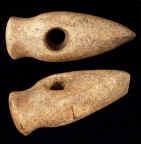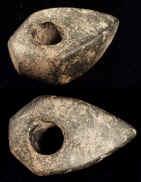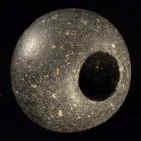







Looking After Your Finds - Identification - Finds






Powered By Sispro1

Fibulae1
Neolithic - Early Bronze Age Stone Tools
19. NEOLITHIC / EARLY BRONZE AGE FLINT AXE
SOUTH-EASTERN EUROPE 2nd MILLENNIUM B.C.
Light cream-grey flint of trapezium shape with slightly convex sides, rectangular cross-section, convex cutting edge, finely polished.
L. 4" (10.2 cm).
SOUTH-EASTERN EUROPE 2nd MILLENNIUM B.C.
Light cream-grey flint of trapezium shape with slightly convex sides, rectangular cross-section, convex cutting edge, finely polished.
L. 4" (10.2 cm).
20. NEOLITHIC / EARLY BRONZE AGE FLINT AXE
SOUTH-EASTERN EUROPE 2nd MILLENNIUM B.C.
Light grey flint of trapezium shape with slightly convex sides, rectangular cross-section, convex cutting edge, finely polished blade.
L. 5.2" (13.3 cm).
SOUTH-EASTERN EUROPE 2nd MILLENNIUM B.C.
Light grey flint of trapezium shape with slightly convex sides, rectangular cross-section, convex cutting edge, finely polished blade.
L. 5.2" (13.3 cm).
21. NEOLITHIC-EARLY BRONZE AGE FLINT AXE
SOUTH-EASTERN EUROPE 2nd MILLENNIUM B.C.
Light gray-blue flint, trapezium shape with rectangular cross-section, slightly concave sides, convex cutting edge, finely polished blade.
L. 6.5" (16.5 cm).
SOUTH-EASTERN EUROPE 2nd MILLENNIUM B.C.
Light gray-blue flint, trapezium shape with rectangular cross-section, slightly concave sides, convex cutting edge, finely polished blade.
L. 6.5" (16.5 cm).
22. NEOLITHIC-EARLY BRONZE AGE FLINT AXE
SOUTH-EASTERN EUROPE 2nd MILLENNIUM B.C.
Dark gray flint with white dotted inclusions. Trapezium shape with rectangular cross-section, slightly concave sides, convex cutting edge, finely polished blade. . L. 6.6" (16.8 cm).
SOUTH-EASTERN EUROPE 2nd MILLENNIUM B.C.
Dark gray flint with white dotted inclusions. Trapezium shape with rectangular cross-section, slightly concave sides, convex cutting edge, finely polished blade. . L. 6.6" (16.8 cm).
23. NEOLITHIC-EARLY BRONZE AGE STONE AXE
EUROPE 2nd MILLENNIUM B.C.
Gray granite. Wedge-shaped with rectangular cross-section, convex cutting edge. Incomplete socket hole.
L. 3.9" (9.9 cm), H. 1.8 (4.8 cm).
EUROPE 2nd MILLENNIUM B.C.
Gray granite. Wedge-shaped with rectangular cross-section, convex cutting edge. Incomplete socket hole.
L. 3.9" (9.9 cm), H. 1.8 (4.8 cm).
24. NEOLITHIC / EARLY BRONZE AGE STONE AXE
SOUTH-EASTERN EUROPE 2nd MILLENNIUM B.C.
Gray-brown granite. Irregular diamond-shaped with rounded corners, rectangular cross-section; butt is emphasized, horizontal cutting edge. Drilled from both ends, leaving horizontal parallel grooves. Ground finish. L. 4.5" (11.4 cm), H. 1.3 (3.3 cm).
SOUTH-EASTERN EUROPE 2nd MILLENNIUM B.C.
Gray-brown granite. Irregular diamond-shaped with rounded corners, rectangular cross-section; butt is emphasized, horizontal cutting edge. Drilled from both ends, leaving horizontal parallel grooves. Ground finish. L. 4.5" (11.4 cm), H. 1.3 (3.3 cm).
25. NEOLITHIC-EARLY BRONZE AGE CEREMONIAL AXE
EUROPE 25-17 c. B.C.
Made of dense dark stone, structurally divided into blade with crescent-shaped cutting edge, wide middle part with vertical shaft-hole and a round butt. Top plane slightly concave, the bottom one is flat. Finely polished all over. Drilled from both ends, leaving horizontal parallel grooves, different diameters of top and bottom.
L. 3.6" (9.1 cm), H. 1.8" (4.6 cm).
Blade is smoothly rounded, excluding its use as functional cutting tool. Its been suggested it was either a parade weapon or insignia of power.
EUROPE 25-17 c. B.C.
Made of dense dark stone, structurally divided into blade with crescent-shaped cutting edge, wide middle part with vertical shaft-hole and a round butt. Top plane slightly concave, the bottom one is flat. Finely polished all over. Drilled from both ends, leaving horizontal parallel grooves, different diameters of top and bottom.
L. 3.6" (9.1 cm), H. 1.8" (4.6 cm).
Blade is smoothly rounded, excluding its use as functional cutting tool. Its been suggested it was either a parade weapon or insignia of power.
26. NEOLITHIC-EARLY BRONZE AGE BATTLE AXE
EUROPE 21-17 c. B.C.
Made of gray and brown speckled stone, structurally divided into blade with straight cutting edge, wide middle part with vertical shaft-hole and a prominent round butt. Top plane slightly concave, the bottom one is flat. Polished all over. Drilled from both ends, leaving horizontal parallel grooves, different diameters of top and bottom. L. 5.3" (13.5 cm)
EUROPE 21-17 c. B.C.
Made of gray and brown speckled stone, structurally divided into blade with straight cutting edge, wide middle part with vertical shaft-hole and a prominent round butt. Top plane slightly concave, the bottom one is flat. Polished all over. Drilled from both ends, leaving horizontal parallel grooves, different diameters of top and bottom. L. 5.3" (13.5 cm)
27. NEOLITHIC / EARLY BRONZE AGE BATTLE AXE
EUROPE 25-15 c. B.C.
Black dense stone. Wedge-shaped with rectangular cross-section, convex cutting edge; butt is emphasized, with oval face. Drilled from one end, conical opening. Finely polished all over.
L. 3.4" (8.6 cm), H. 1.5" (3.8 cm).
EUROPE 25-15 c. B.C.
Black dense stone. Wedge-shaped with rectangular cross-section, convex cutting edge; butt is emphasized, with oval face. Drilled from one end, conical opening. Finely polished all over.
L. 3.4" (8.6 cm), H. 1.5" (3.8 cm).









28. NEOLITHIC / EARLY BRONZE AGE BATTLE AXE EUROPE
25-17 c. B.C.
Made of dense dark stone, structurally divided into blade with hook shaped cutting edge, wide middle part with vertical shaft-hole and a round butt. Top plane slightly concave, the bottom one is flat. Finely polished all over. Drilled from one end, leaving horizontal parallel grooves, different diameters of top and bottom. Intact. L. 5" (12.7 cm).
25-17 c. B.C.
Made of dense dark stone, structurally divided into blade with hook shaped cutting edge, wide middle part with vertical shaft-hole and a round butt. Top plane slightly concave, the bottom one is flat. Finely polished all over. Drilled from one end, leaving horizontal parallel grooves, different diameters of top and bottom. Intact. L. 5" (12.7 cm).
29. NEOLITHIC-EARLY BRONZE AGE STONE MACE HEAD
SOUTH-EASTERN EUROPE 21-17 c. B.C.
Compressed sphere of dense, black stone and finely polished. Drilled from one end, large conical opening.
D. 2.3" (5.8 cm), H. 1.8" (4.6 cm).
SOUTH-EASTERN EUROPE 21-17 c. B.C.
Compressed sphere of dense, black stone and finely polished. Drilled from one end, large conical opening.
D. 2.3" (5.8 cm), H. 1.8" (4.6 cm).
30. NEOLITHIC-EARLY BRONZE AGE FLINT SICKLE
SOUTH-EASTERN EUROPE 21-15 c. B.C.
Light gray flint. Cutting portion of sickle has typical polish as a result of working with grain-crops. Milky-blue patina. L. 5.6" (14.2 cm).
SOUTH-EASTERN EUROPE 21-15 c. B.C.
Light gray flint. Cutting portion of sickle has typical polish as a result of working with grain-crops. Milky-blue patina. L. 5.6" (14.2 cm).
31. NEOLITHIC-EARLY BRONZE AGE FLINT SICKLE
SOUTH-EASTERN EUROPE 21-15 c. B.C.
Light gray flint. Cutting portion of sickle has typical polish as a result of working with grain-crops. L. 5.6" (14.2 cm).
SOUTH-EASTERN EUROPE 21-15 c. B.C.
Light gray flint. Cutting portion of sickle has typical polish as a result of working with grain-crops. L. 5.6" (14.2 cm).
32. NEOLITHIC - EARLY BRONZE AGE FLINT ADZE
SOUTH-EASTERN EUROPE 2nd MILLENNIUM B.C.
Grey flint of triangular shape with biconvex cross-section, convex cutting edge, finely polished blade. Cutting planes have different angles to longitudinal axis. L. 5.4" (13.7 cm).
SOUTH-EASTERN EUROPE 2nd MILLENNIUM B.C.
Grey flint of triangular shape with biconvex cross-section, convex cutting edge, finely polished blade. Cutting planes have different angles to longitudinal axis. L. 5.4" (13.7 cm).
33. NEOLITHIC-EARLY BRONZE AGE FLINT ADZE
SOUTH-EASTERN EUROPE 2nd MILLENNIUM B.C.
Light gray flint, trapezium shape with rectangular cross-section, slightly convex sides and cutting edge, finely polished.
L. 5.1" (13 cm).
SOUTH-EASTERN EUROPE 2nd MILLENNIUM B.C.
Light gray flint, trapezium shape with rectangular cross-section, slightly convex sides and cutting edge, finely polished.
L. 5.1" (13 cm).






Copyright All Rights Reserved by Nigel G Wilcox E-Mail: ngwilcox100@gmail.com
Designed by Nigel G Wilcox
Complimentary Topics
The Paragon Of Metal Detecting
& Archaeology
& Archaeology
Pages
Main Coin Menu
Member NCMD
Specialised. Menu






















